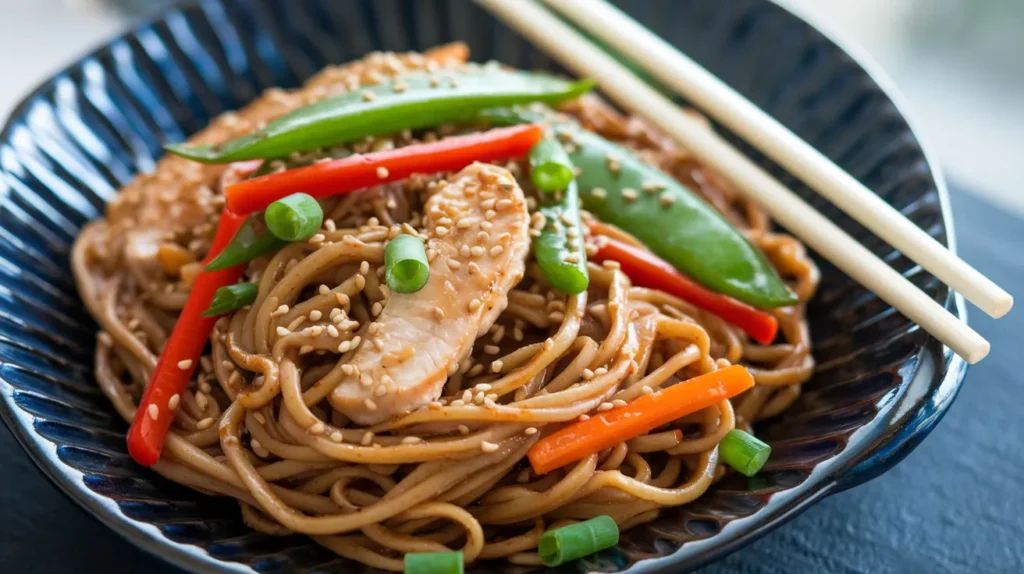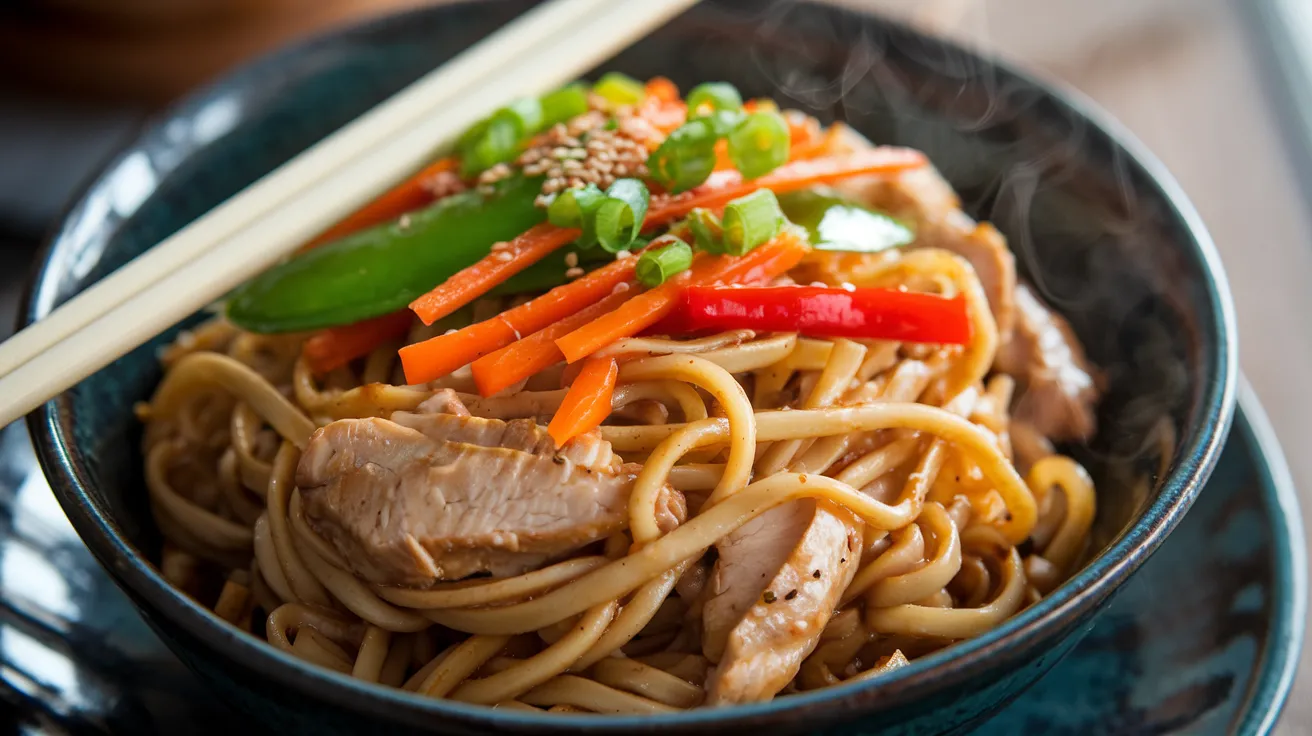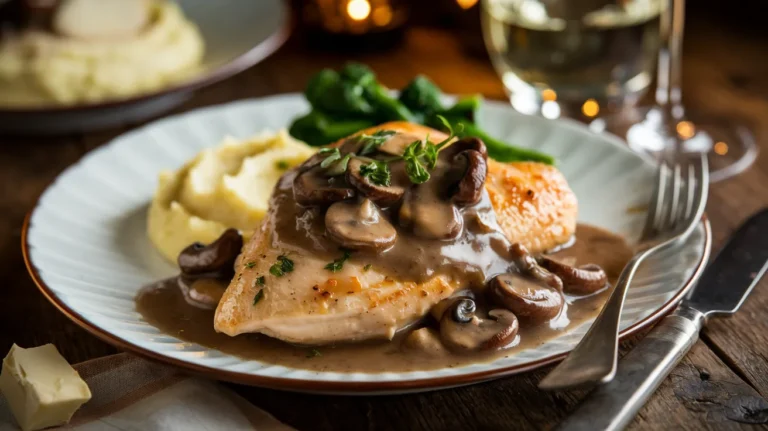Key Takeaways:
- This Garlic Chicken Lo Mein Recipe is ready in just 30 minutes with simple pantry ingredients
- Creates 4 generous portions for family dinner
- Uses one-pan cooking technique for minimal cleanup
- Customizable with any vegetables you have on hand
Skip the Delivery and Make This Instead
Ever stared at your phone, finger hovering over the “order now” button for Chinese takeout? We’ve all been there. But what if you could create that same savory, satisfying Garlic Chicken Lo Mein Recipe at home in less time than delivery?
This Garlic Chicken Lo Mein Recipe transforms basic ingredients into restaurant-quality noodles. With tender chicken strips, crisp vegetables, and egg noodles tossed in a savory garlic sauce, you’ll wonder why you ever ordered out. If you enjoy Asian-inspired chicken dishes, this recipe delivers the same satisfaction as my Sweet and Spicy Chicken Wings but with noodles as the star. Best of all, it comes together in just 30 minutes for four hungry people.
Nutrition Facts
| Nutrient | Amount Per Serving |
|---|---|
| Calories | 425 |
| Protein | 28g |
| Carbohydrates | 52g |
| Fat | 12g |
| Fiber | 4g |
| Sodium | 720mg |
| Sugar | 6g |
Nutrition information based on 4 servings
Equipment & Ingredients
What You’ll Need
| Kitchen Tools | Purpose |
|---|---|
| Large wok or 12-inch skillet | Main cooking vessel |
| Sharp knife | For cutting chicken and vegetables |
| Cutting board | Prep surface |
| Large pot | For boiling noodles |
| Colander | For draining noodles |
| Measuring cups and spoons | For accurate measurements |
| Tongs | For tossing noodles |
| Small bowl | For mixing sauce |
| Whisk | For combining sauce ingredients |
Ingredients List
| Ingredient | Measurement | Notes |
|---|---|---|
| For the Chicken & Noodles: | ||
| Boneless, skinless chicken breasts | 1 pound | Cut into thin strips |
| Lo mein noodles or spaghetti | 8 ounces | |
| Red bell pepper | 1 medium | Thinly sliced |
| Carrots | 2 medium | Julienned |
| Snow peas | 1 cup | Trimmed |
| Green onions | 4 | Sliced, whites and greens separated |
| Garlic | 4 cloves | Minced |
| Fresh ginger | 1 tablespoon | Grated |
| Vegetable oil | 2 tablespoons | Divided |
| For the Sauce: | ||
| Low-sodium soy sauce | ¼ cup | |
| Chicken broth | ¼ cup | |
| Oyster sauce | 2 tablespoons | |
| Brown sugar | 1 tablespoon | |
| Sesame oil | 1 teaspoon | |
| Cornstarch | 1 tablespoon | |
| Red pepper flakes | ¼ teaspoon | Optional, for heat |
Possible Substitutions
- Protein options: Swap chicken for beef strips, shrimp, or tofu
- Noodle alternatives: Use yakisoba, ramen, or whole wheat spaghetti
- Vegetable varieties: Any stir-fry friendly veggies work (broccoli, mushrooms, bok choy)
- Oyster sauce substitute: Hoisin sauce or additional soy sauce with a pinch of sugar
- Gluten-free option: Use rice noodles and tamari instead of soy sauce
Prep Time, Cook Time, & Total Time
- Prep Time: 15 minutes
- Cook Time: 15 minutes
- Total Time: 30 minutes
- Servings: 4
Step-by-Step Instructions for Beginners
Preparation Phase
- Set up your workspace
- Clear your countertop to give yourself plenty of room to work
- Read through the entire recipe once before starting
- Place a small bowl on the counter for sauce ingredients
- Place a large plate or bowl nearby for your prepped vegetables
- Set out a clean plate for the cooked chicken
- Place your cutting board in a stable position
- Start the water for noodles
- Fill a large pot about ¾ full with water (about 3-4 quarts)
- Add 1 tablespoon of salt to the water
- Place on stove over high heat to bring to a boil
- Note: It may take 8-10 minutes to reach a full boil, which gives you time to prep other ingredients
- Prepare the sauce (while water heats)
- Find a small bowl for your sauce mixture
- Measure and add ¼ cup low-sodium soy sauce
- Measure and add ¼ cup chicken broth
- Measure and add 2 tablespoons oyster sauce
- Measure and add 1 tablespoon brown sugar
- Measure and add 1 teaspoon sesame oil
- Measure and add 1 tablespoon cornstarch
- Add ¼ teaspoon red pepper flakes (optional)
- Using a whisk or fork, stir vigorously for 30-45 seconds until completely combined
- Beginner tip: Cornstarch tends to settle at the bottom, so make sure to scrape the bottom of the bowl while whisking
- Set sauce aside but keep the whisk nearby for another quick stir before using
- Prepare the chicken
- Place chicken breasts on cutting board
- Using paper towels, pat the chicken completely dry on both sides
- Why this matters: Dry chicken will brown better and not steam in the pan
- Place one chicken breast on its side and hold it steady with your non-cutting hand
- With your knife at a slight angle, cut the chicken against the grain (perpendicular to the visible muscle fibers) into ¼-inch thick strips
- Beginner tip: If the chicken is slippery or difficult to cut, place it in the freezer for 15 minutes to firm up
- Repeat with remaining chicken
- Season chicken strips lightly with ¼ teaspoon salt and ¼ teaspoon black pepper
- Set aside on a clean plate
- For more tips on working with chicken, check out my Delicious Baked Chicken Legs recipe which shares techniques for proper chicken preparation
- Prepare the vegetables (cutting techniques explained)
- For carrots:
- Wash and peel 2 medium carrots
- Cut off and discard the top and bottom ends
- Cut each carrot in half crosswise
- Place flat side down on cutting board for stability
- Slice lengthwise into ⅛-inch thick planks
- Stack 2-3 planks at a time
- Cut lengthwise again into matchstick-sized pieces (julienne)
- For red bell pepper:
- Stand pepper upright on cutting board
- Slice down each side, avoiding the core and seeds (4 cuts total)
- Discard the core and seeds
- Place each pepper piece skin-side down
- Slice into ¼-inch wide strips
- For snow peas:
- Wash snow peas under cold water
- Pinch the tough end of each pod where it connected to the plant
- Pull gently to remove the string that runs along the pod
- Repeat for all snow peas
- For green onions:
- Trim off and discard the root ends
- Cut off the top 1-inch of the green parts if they look wilted
- Place green onions parallel to each other
- Cut where the green parts meet the white/light green parts
- Slice both parts separately into thin rounds (about ⅛-inch thick)
- Place white and green parts in separate piles (they’ll be used at different times)
- For garlic:
- Separate 4 cloves from the head
- Place the flat side of your knife on each clove
- Press down firmly with the heel of your hand to crush
- Remove and discard the papery skin
- Finely chop the garlic by rocking your knife back and forth over the cloves
- Beginner tip: Don’t cut garlic too far in advance as it can develop a bitter flavor
- For ginger:
- Use a spoon to scrape off the brown skin from a 1-inch piece of ginger
- Grate using the fine side of a box grater or a microplane
- Continue until you have 1 tablespoon of grated ginger
- Beginner tip: Fresh ginger can be stored in the freezer and grated while frozen
- For carrots:
- Organize your prepped ingredients
- Place all cut vegetables in separate piles on a large plate or in small bowls
- Have your chicken plate nearby
- Keep your sauce mixture within reach
- Beginner tip: This organization (called “mise en place”) makes the cooking process much smoother
Cooking Phase
- Cook the noodles
- Once water is at a rolling boil (large bubbles breaking the surface continuously)
- Add 8 ounces of lo mein noodles or spaghetti to the water
- Stir immediately with a fork or tongs to prevent sticking
- Set a timer according to package directions (usually 4-6 minutes)
- Test for doneness: At the minimum time suggested, remove one noodle, run under cold water and taste
- Noodles should be slightly firm (al dente) as they’ll cook more in the sauce
- Once done, place colander in sink
- Carefully pour noodles and water into colander to drain
- Safety tip: Pour away from your body to avoid steam burns
- Rinse noodles under cold running water for 30 seconds while gently tossing
- Allow to drain for 30 seconds
- Return noodles to the empty pot
- Add 1 teaspoon oil and toss gently with tongs to prevent sticking
- Set aside
- Cook the chicken
- Place your wok or large skillet on the stove
- Turn heat to medium-high
- Add 1 tablespoon vegetable oil
- Allow oil to heat until it shimmers slightly (about 30 seconds)
- Test if pan is hot enough: Flick a tiny drop of water into the pan – it should sizzle immediately
- Using tongs or your fingers, carefully add chicken strips in a single layer
- Important: Leave space between pieces – work in two batches if necessary
- Let chicken cook undisturbed for 2 minutes (resist the urge to move it!)
- Using tongs, flip each piece to the other side
- Cook for another 2 minutes until no pink remains
- Check for doneness: Cut into thickest piece – should be white throughout
- Transfer chicken to a clean plate
- Beginner tip: Overcrowding the pan will steam rather than sear the chicken
- Cook the aromatics and vegetables
- Using the same pan (don’t wash it), add remaining 1 tablespoon oil
- Add white parts of green onions, minced garlic, and grated ginger
- Stir constantly for exactly 30 seconds
- Caution: Garlic burns easily and becomes bitter – keep it moving!
- Add carrots and bell pepper
- Stir-fry for 2 minutes, tossing frequently with tongs or a spatula
- Beginner tip: If pan seems too hot (ingredients are browning too quickly), reduce heat slightly
- Add snow peas
- Continue stir-frying for 1 more minute
- Vegetables should be bright in color and slightly tender but still crisp
- Combine and finish the dish
- Give your sauce a quick whisk to recombine ingredients
- Return cooked chicken to the pan with vegetables
- Add the drained noodles
- Pour sauce evenly over everything
- Using tongs, gently lift and toss all ingredients continuously
- Make sure to scrape the bottom of the pan where sauce will begin to thicken
- Continue tossing for 2-3 minutes until sauce coats everything and thickens slightly
- Visual cue: Sauce will change from watery to glossy
- Add green parts of green onions
- Toss once more to combine
- Turn off heat
- Beginner tip: If sauce becomes too thick, add 1-2 tablespoons of water
Serving Phase
- Serve immediately
- Warm four serving bowls or plates if possible
- Using tongs, divide lo mein evenly among the four serving dishes
- Make sure each serving has a good mix of noodles, vegetables, and chicken
- Garnish each dish with any remaining green onions
- Optional: Sprinkle with sesame seeds (1 teaspoon per serving)
- Serve with additional soy sauce on the side if desired
- Beginner tip: Chopsticks work well for eating, but forks are perfectly fine too!

Troubleshooting Tips
Common Issues and Solutions
Problem: Sauce is too thin
- Mix 1 teaspoon cornstarch with 1 tablespoon cold water in a small bowl
- Stir until completely dissolved
- Drizzle into the pan while stirring constantly
- Cook for an additional minute until thickened
Problem: Sauce is too thick
- Add 1 tablespoon water or chicken broth at a time
- Stir until desired consistency is reached
- Continue to cook for 30 seconds after each addition
Problem: Noodles are clumping together
- Make sure to rinse noodles with cold water immediately after cooking
- Toss with 1 teaspoon oil right after draining
- If already clumped, separate under warm running water then drain again
- For serving, a splash of warm broth can help loosen noodles
Problem: Chicken is tough or dry
- Make sure not to overcook the chicken (no more than 4 minutes total)
- Cut chicken pieces uniformly for even cooking
- Let chicken rest a minute before cutting if using pre-cooked chicken
- Next time, consider marinating chicken in 1 tablespoon soy sauce for 15 minutes before cooking
Problem: Vegetables are too crunchy
- Continue cooking 1-2 minutes longer
- Add 2 tablespoons water to the pan and cover with a lid for 1 minute to steam
- Cut vegetables into smaller pieces next time
Problem: Vegetables are too soft
- Reduce cooking time next time
- Add firmer vegetables (carrots) first, followed by softer ones (snow peas)
- Plunge vegetables in ice water immediately if overcooked to stop the cooking process
Problem: Garlic or ginger burned
- If just beginning to brown, continue but reduce heat
- If black and bitter, start over with fresh garlic/ginger and clean pan
- Next time, add garlic/ginger after harder vegetables have partially cooked
Variations & Substitutions
Make It Your Own
Spicy Garlic Chicken Lo Mein Recipe
- Add 1-2 tablespoons of chili garlic sauce to the sauce mixture
- Include sliced fresh jalapeños with the vegetables
- Finish with a sprinkle of red pepper flakes
Vegetarian Lo Mein
- Omit chicken and double the vegetables
- Add 8 ounces of cubed firm tofu (pressed and patted dry)
- Or add 1 cup of edamame for protein
- Consider adding sliced mushrooms for meaty texture
Seafood Lo Mein
- Replace chicken with 1 pound of peeled, deveined shrimp
- Reduce cooking time to 1-2 minutes per side for shrimp
- Shrimp will turn pink and curl into a C-shape when done
Budget-Friendly Version
- Use frozen mixed vegetables instead of fresh (2 cups total)
- Substitute 1 teaspoon dried ginger powder for fresh ginger
- Use garlic powder (½ teaspoon) if fresh garlic unavailable
- Use chicken thighs instead of breasts (often cheaper)
Weekend Prep Version
- Cut all vegetables up to 2 days ahead, store in airtight containers
- Mix sauce up to 3 days ahead, store in refrigerator
- Cook chicken 1 day ahead, slice and refrigerate
Storage & Reheating
Keep It Fresh
Refrigerator Storage:
- Allow lo mein to cool completely before storing (no more than 2 hours at room temperature)
- Divide into individual portions for easier reheating
- Place in airtight containers
- Label with the date
- Keeps for up to 3 days in refrigerator
Freezing Option:
- Not recommended for freezing as noodles can become mushy
- If you must freeze, slightly undercook noodles and vegetables
- Use within 1 month
- Thaw overnight in refrigerator before reheating
Reheating Instructions:
- Microwave Method:
- Place single portion in microwave-safe dish
- Add 1 tablespoon water or broth
- Cover with damp paper towel
- Heat for 1 minute
- Stir thoroughly
- Continue heating in 30-second intervals until hot throughout (165°F)
- Stir between each interval
- Stovetop Method (preferred for better texture):
- Place non-stick skillet over medium heat
- Add 1-2 tablespoons water or chicken broth
- Add leftover lo mein
- Toss gently with tongs while heating
- Cook until internal temperature reaches 165°F (about 4-5 minutes)
- Add a splash more liquid if it begins to stick
Safety Notes & Tips
Important Reminders
Food Safety:
- Wash hands with soap for 20 seconds before handling food
- Clean all surfaces and cutting boards with hot, soapy water
- Use separate cutting boards for raw chicken and vegetables
- Chicken must reach internal temperature of 165°F (74°C)
- Don’t reuse marinade or cooking utensils that touched raw chicken
- Refrigerate leftovers within 2 hours of cooking
- Never leave perishable ingredients at room temperature for more than 2 hours
Cooking Tips:
- Prep all ingredients before heating the wok (mise en place)
- Use high heat for authentic stir-fry flavor
- Keep ingredients moving in the pan to prevent burning
- Don’t overcrowd the pan when cooking chicken or vegetables
- Taste as you go (except when raw chicken is involved)
- Adjust seasonings at the end if needed
Beginner Tips:
- If you’re new to stir-frying, cook in smaller batches
- Have all ingredients prepped and within reach before starting
- A splatter screen can help reduce cleanup
- For easier slicing, partially freeze chicken for 15-20 minutes
- If you’re nervous about timing, prepare one element at a time (cook chicken, remove; cook vegetables, remove; combine all at end)
- When in doubt, undercook vegetables slightly – they’ll continue cooking from residual heat
- If you enjoy this Garlic Chicken Lo Mein Recipe, you might also like my Chicken Nanban for another Asian-inspired dish with a different flavor profile
Kitchen Safety:
- Turn pot handles inward to prevent accidental spills
- Keep a kitchen towel or oven mitt nearby for hot handles
- Use caution when draining hot water from noodles
- Clean spills immediately to prevent slipping
- Keep a fire extinguisher accessible and know how to use it
Dietary Notes: This Garlic Chicken Lo Mein Recipe contains wheat (noodles), soy, and animal products. For gluten-free version, use rice noodles and tamari soy sauce.




